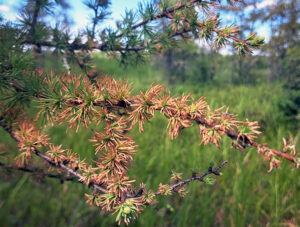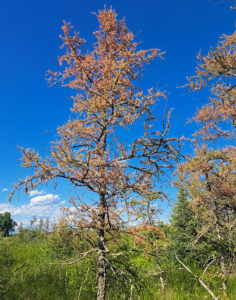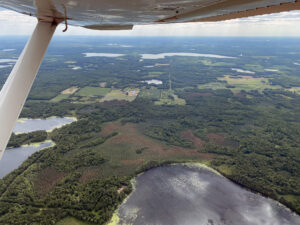By Paul Cigan, DNR Forest Health Specialist, Hayward;
Paul.Cigan@wisconsin.gov or 715-416-4920

A tamarack branch shows severe needle mining from larch casebearer. / Photo Credit: Paul Cigan, Wisconsin DNR
Larch casebearer has caused localized heavy defoliation in some tamarack swamps in central Burnett County this spring, causing tamarack to stand out with a stark appearance of bright-brown foliage by mid-June.
Larvae of this exotic moth damage tamarack needles by “mining” the inner needle tissue. Heavily damaged tamarack progress in color from pale green to yellow and eventually turn a bright, reddish brown as needles dry out and die.

Tamarack needles with larch casebearer feeding damage, along with the presence of a pupa in a case and an adult moth. / Photo Credit: Paul Cigan, Wisconsin DNR
Larvae pupate into adults in early June and conceal themselves in the shells of hollowed-out needles — ”cases” — attached to host needles. Some additional defoliation will occur from midsummer through fall as eggs hatch and undergo three developmental stages (instars).
Moderate to heavily defoliated tamarack produce a second flush of needles in midsummer and usually tolerate several consecutive years of defoliation before sustaining severe crown dieback and mortality. Repeated defoliation events, however, do weaken trees and make them more susceptible to attack by the native eastern larch beetle, which often leads to tamarack mortality.
Larch casebearer populations are usually controlled by native and introduced predators, needle diseases that kill needles and cause the larvae to starve, and harsh weather conditions such as late frosts. Management is not usually recommended. Insecticides should be used only to protect high-value ornamental trees.

A tamarack tree shows bright brown foliage caused by larch casebearer feeding injury. / Photo Credit: Paul Cigan, Wisconsin DNR

Aerial view of larch casebeaer defoliation of tamarack in Burnett County. / Photo Credit: Paul Cigan, Wisconsin DNR
